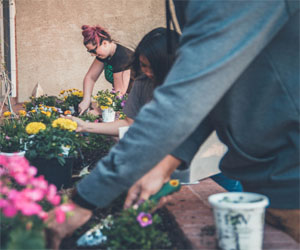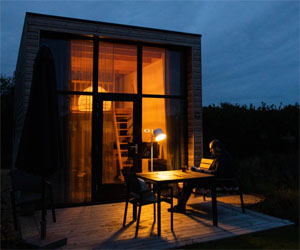


Cultivating Wellness Through Nature

Gardening is more than just a hobby; it's a therapeutic and health-enhancing activity that can significantly improve your physical, mental, and emotional well-being. From reducing stress to increasing physical activity, there are numerous ways in which gardening contributes to a healthier, happier life. In this article, we'll explore the many benefits of gardening for health and provide tips for harnessing the power of nature in your outdoor space.
Stress Reduction: The act of gardening, with its rhythmic tasks like planting, weeding, and watering, has a calming effect on the mind. Engaging with nature and the tactile experience of working in the garden can reduce stress and anxiety levels. The peace and tranquility of a garden offer a therapeutic escape from the demands of daily life.
Physical Exercise: Gardening is an excellent form of physical activity. Activities such as digging, planting, and weeding can provide a full-body workout, improving strength, flexibility, and cardiovascular health. Spending time outdoors in the fresh air and sunlight also promotes vitamin D synthesis and overall well-being.
Healthy Eating: Many gardeners grow their fruits and vegetables, which encourages a diet rich in fresh, organic produce. Homegrown fruits and vegetables are often more nutritious than store-bought alternatives, as they can be harvested at their peak ripeness and consumed immediately.
Mental Well-Being: Gardening has been linked to improved mental health. The sense of accomplishment that comes from nurturing plants and watching them flourish can boost self-esteem and mood. The creative aspect of garden design can also stimulate mental faculties.
Connection With Nature: Gardening fosters a stronger connection to the natural world. It deepens our understanding of the environment and our place within it. This connection can lead to a greater appreciation for nature's wonders and a sense of stewardship for the planet.
Mindfulness And Presence: Gardening encourages mindfulness and living in the present moment. As you tend to your plants, you become fully engrossed in the task at hand, allowing your mind to let go of worries and stress. The sounds, scents, and tactile sensations of the garden create a sensory experience that keeps you rooted in the here and now.
Community And Social Interaction: Many communities have gardening clubs and shared garden spaces, promoting social interaction and a sense of belonging. Gardening alongside others can provide opportunities for camaraderie and the exchange of knowledge.
Healing Benefits: Therapeutic gardening programs have shown remarkable benefits for individuals with physical and mental health challenges. Horticultural therapy, a structured and goal-oriented form of gardening, is used to improve the well-being and quality of life of people dealing with a range of conditions, from dementia to physical disabilities.
Tips For Gardening For Health:
Start Small: If you're new to gardening, begin with a small area or a few potted plants to build your confidence and experience the benefits.
Choose Plants You Love: Select plants and flowers that bring you joy and resonate with your personal tastes. Gardening should be an enjoyable and fulfilling experience.
Be Mindful: While gardening, focus on the task at hand and engage your senses in the experience. Notice the textures, colors, and scents around you.
Take Breaks: Avoid overexertion by taking regular breaks and staying hydrated. Gardening should be a pleasure, not a source of physical strain.
Embrace Gardening Activities: Experiment with various gardening activities, from planting to harvesting, to keep the experience fresh and engaging.
Gardening is a holistic and life-enriching activity that supports physical health, mental well-being, and a deeper connection to the natural world. Whether you have a spacious backyard or a small balcony, you can cultivate wellness through gardening. By nurturing your green space, you nurture your own health and happiness.


Embracing Minimalism For A More Fulfilling Life
 3. Simplify Your Wardrobe
3. Simplify Your Wardrobe
A minimalist wardrobe typically consists of versatile, timeless pieces that can be mixed and matched. This not only makes getting dressed in the morning easier but also reduces the time and money spent on clothing. A smaller wardrobe can be more reflective of your personal style and eliminate the stress of decision fatigue.
4. Quality Over Quantity
In a world where we are often encouraged to buy more for less, minimalism emphasizes the importance of quality over quantity. Instead of opting for numerous inexpensive items, invest in high-quality products that are built to last. This not only reduces waste but also leads to a more cost-effective and satisfying life in the long run.
5. Mindful Consumption
Minimalism promotes mindful consumption. Before making a purchase, think about whether the item aligns with your values and needs. Consider whether it will enhance your life or merely contribute to clutter. Being mindful of what you bring into your life can lead to more intentional and fulfilling choices.
6. Reduced Environmental Impact
By living with less and consuming mindfully, minimalism can have a positive impact on the environment. Reducing waste, conserving resources, and making eco-friendly choices are intrinsic to this way of life, which ultimately contributes to a more sustainable planet.
The Power Of Gardening Communities
 5. Social Interaction: Gardening is a solitary activity for many, but being part of a gardening community can alleviate the isolation. Whether you're participating in a local club's meetings or engaging in online discussions, these interactions offer the chance to connect with like-minded individuals who share your passion for plants and the outdoors.
5. Social Interaction: Gardening is a solitary activity for many, but being part of a gardening community can alleviate the isolation. Whether you're participating in a local club's meetings or engaging in online discussions, these interactions offer the chance to connect with like-minded individuals who share your passion for plants and the outdoors.
6. Garden Tours And Events: Gardening communities often organize garden tours and events where members can visit one another's gardens, exchange ideas, and celebrate each other's successes. These events can be a source of inspiration and an opportunity to appreciate the beauty of different gardening styles.
7. Mentorship: Experienced gardeners within a community often take on mentorship roles, guiding newcomers in the art and science of gardening. Mentorship fosters a sense of continuity and tradition, passing down knowledge from one generation of gardeners to the next.
The Art Of Wilderness Living
 Wilderness living is all about embracing the raw and unspoiled natural world. It involves choosing to reside in remote, unpopulated areas, often far from the amenities and comforts of modern civilization. Those who opt for this lifestyle build their homes, forage for food, and harness the elements to survive. It's a challenging yet rewarding way of life that allows individuals to experience a profound sense of freedom, self-sufficiency, and harmony with nature.
Wilderness living is all about embracing the raw and unspoiled natural world. It involves choosing to reside in remote, unpopulated areas, often far from the amenities and comforts of modern civilization. Those who opt for this lifestyle build their homes, forage for food, and harness the elements to survive. It's a challenging yet rewarding way of life that allows individuals to experience a profound sense of freedom, self-sufficiency, and harmony with nature.
One of the fundamental aspects of wilderness living is self-reliance. Those who live in the wild learn to depend on their resourcefulness and creativity to meet their basic needs. Whether it's building shelter from natural materials, hunting, fishing, or foraging for food, these individuals rely on their ingenuity and skills to thrive in a challenging environment.
Living in the wilderness requires adaptability, as nature is unpredictable. The ability to respond to changing conditions, from weather patterns to the availability of food sources, is crucial for survival. Wilderness dwellers must be in tune with the rhythms of the natural world, adapting and learning as they go.
The off-grid lifestyle also emphasizes sustainability. Wilderness living encourages the minimal environmental impact by relying on renewable resources, generating one's own energy, and adopting eco-friendly practices. Sustainability is not just a choice but a necessity when living far from the conveniences of the modern world.
Community plays a significant role in wilderness living. While it may seem like a solitary existence, many individuals who choose this lifestyle join like-minded communities, which provide support, shared knowledge, and a sense of belonging. These communities often come together to share resources, build collective shelters, and ensure their collective well-being.
Ensuring Safe And Sustainable Water Supply
 Rainwater is naturally soft and low in mineral content, making it an appealing alternative water source. In areas where access to clean, safe drinking water is limited, treating rainwater can provide a reliable supply. Additionally, rainwater treatment supports sustainable water management practices by reducing the burden on traditional water sources.
Rainwater is naturally soft and low in mineral content, making it an appealing alternative water source. In areas where access to clean, safe drinking water is limited, treating rainwater can provide a reliable supply. Additionally, rainwater treatment supports sustainable water management practices by reducing the burden on traditional water sources.
The Rainwater Treatment Process
Filtration: The first step in rainwater treatment is filtration. This process involves the removal of physical impurities such as leaves, twigs, and debris. Mesh screens and sediment filters are commonly used for this purpose.
Storage: Rainwater is often collected in storage tanks or cisterns. Proper storage is essential to prevent the growth of algae and the contamination of the water by external factors.
A Sustainable Future
 Defining Environmentally Friendly Homes
Defining Environmentally Friendly Homes
Environmentally friendly homes, often referred to as eco-friendly or green homes, are constructed and operated with a focus on reducing their impact on the environment. These homes adopt a holistic approach to sustainability, addressing various aspects of the building's design, construction, and operation. The goal is to minimize resource consumption, reduce energy usage, and limit greenhouse gas emissions.
Key Features Of Environmentally Friendly Homes
Energy Efficiency: Environmentally friendly homes prioritize energy efficiency through measures like well-insulated walls, roofs, and windows. They often incorporate high-efficiency heating and cooling systems and utilize energy-efficient lighting and appliances to reduce energy consumption.
A Glimpse Into Tomorrow's Living Spaces
 A Symphony Of Automation And Connectivity
A Symphony Of Automation And Connectivity
The home of the future is a symphony of automation and connectivity. It's a place where technology seamlessly integrates into every aspect of daily life. From the moment you wake up, your home is ready to assist you. Imagine a home where the lights gradually brighten to mimic the natural sunrise, and your coffee maker starts brewing your morning cup as your alarm goes off. This level of automation is now possible thanks to smart home technologies.
Smart Home Upgrades
One of the key elements of the home of the future is the plethora of smart home upgrades available today. These upgrades have revolutionized the way we interact with our living spaces. From intelligent thermostats that adapt to our preferences to security systems that keep a vigilant eye on our property, these technologies hold the potential to elevate our homes into spaces of the future.
The Art Of Minimalist Living
 Declutter And Downsize
Declutter And Downsize
The first step in simplifying your space is to declutter and downsize. Take a critical look at your belongings and ask yourself what truly adds value to your life. Consider the Marie Kondo approach of keeping only those items that "spark joy." Donate or sell what you no longer need, and let go of the excess.
Create Functional Spaces
A simplified space is a functional one. Ensure that every item has its place and purpose. This not only makes it easier to find what you need but also reduces visual clutter. Design your spaces with intention, and be mindful of the flow and purpose of each area.
Choose Quality Over Quantity
In the pursuit of simplification, focus on quality over quantity. Invest in well-made, durable items that are built to last. This not only reduces the need for constant replacements but also brings a sense of craftsmanship and beauty to your space.
Declutter Digitally
In our digital age, it's not just physical clutter that can overwhelm us; digital clutter can be equally burdensome. Simplify your digital life by organizing files, emails, and apps. Unsubscribe from unnecessary emails and unfollow social media accounts that don't bring value to your life.
Reduce Decor
In a simplified space, less is often more when it comes to decor. Choose a few meaningful pieces that resonate with you, rather than overwhelming your space with decorations.
A Step Toward Sustainable Living
 Why Environmentally Mindful Cleaning Matters
Why Environmentally Mindful Cleaning Matters
Traditional cleaning products often contain harsh chemicals and synthetic fragrances that can have adverse effects on our health and the environment. These chemicals, when washed down the drain, find their way into waterways, harming aquatic life and affecting the quality of our drinking water. Moreover, indoor air pollution caused by the release of volatile organic compounds (VOCs) from cleaning products can lead to respiratory problems and other health issues.
Environmentally mindful cleaning is about recognizing the interconnectedness of our actions. It's not just about making our immediate surroundings cleaner; it's about preserving the planet for future generations. By making eco-conscious choices in our cleaning routines, we can significantly reduce our ecological footprint and contribute to a healthier world.
The Green Cleaning Revolution
The shift towards environmentally mindful cleaning practices has given rise to a green cleaning revolution. This movement encourages the use of natural, non-toxic, and sustainable alternatives to conventional cleaning products. Some of the key elements of this revolution include:
Natural Ingredients: Many common household items like vinegar, baking soda, lemon juice, and essential oils can serve as powerful cleaning agents. They are safe, effective, and readily available.
Reducing Plastic Waste: Eco-friendly cleaning often involves the use of refillable and reusable containers, reducing the need for single-use plastic bottles that can take hundreds of years to decompose.